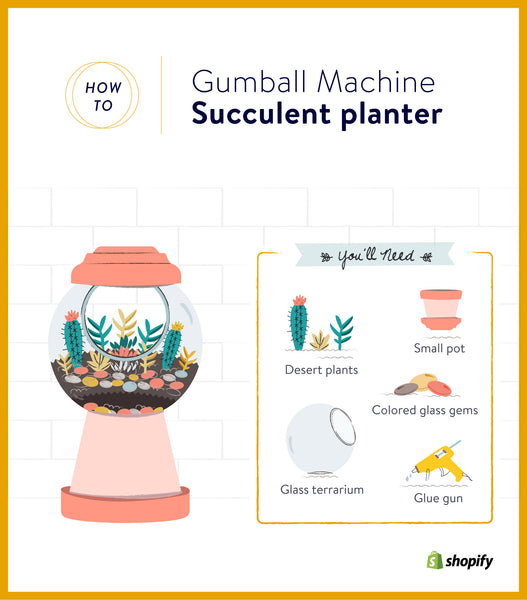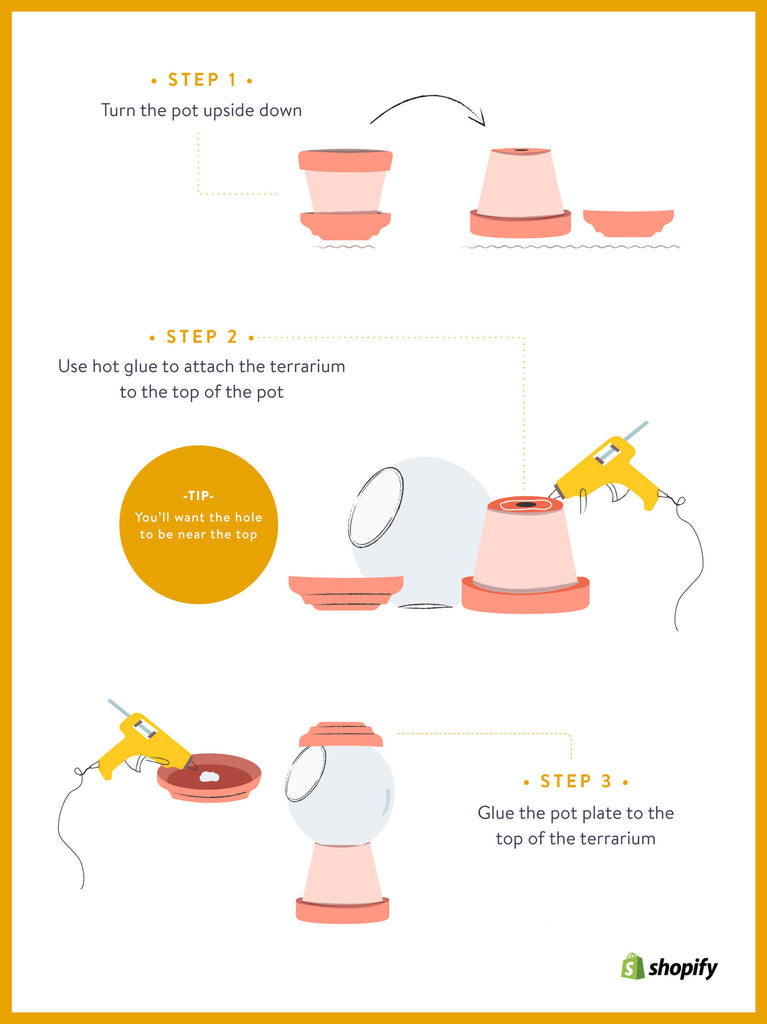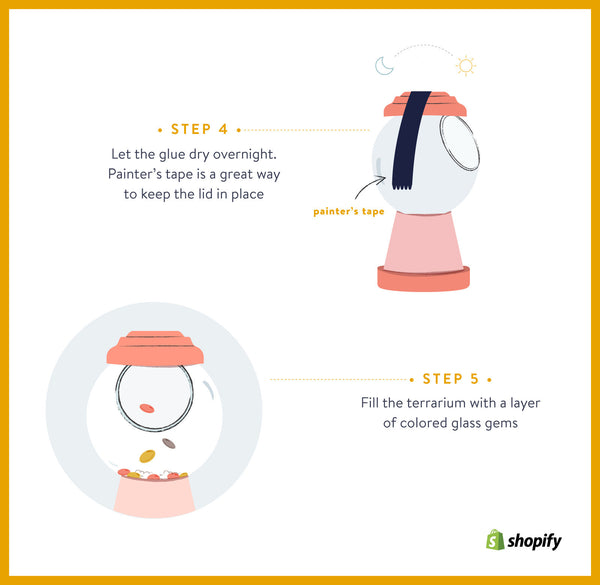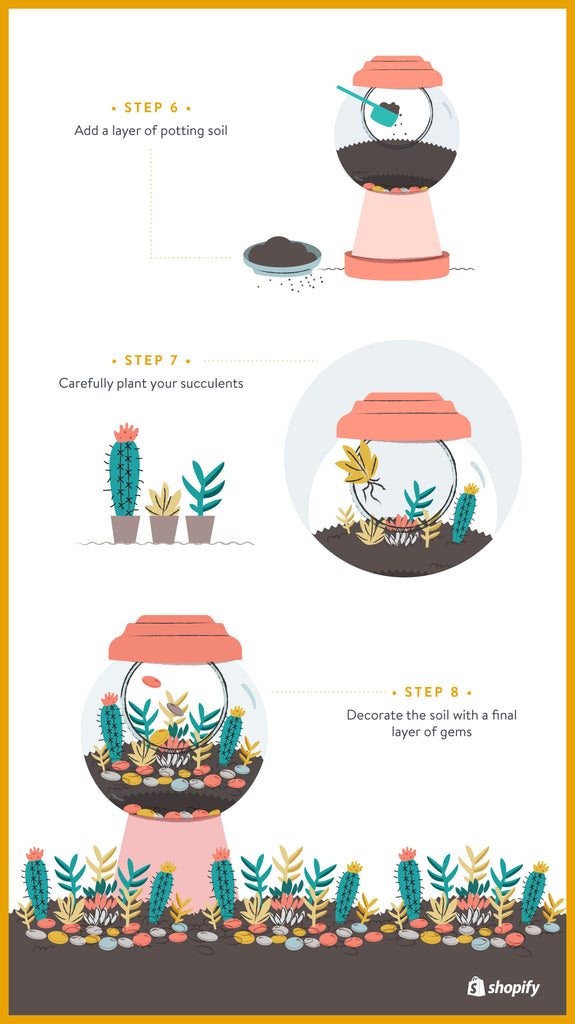When it comes to sprucing up a home, one item in particular is a home décor staple: plants. But if you’re like me and don’t exactly possess a green thumb, then learning how to make a terrarium can be a great green alternative to the typical houseplant.
Terrariums, or tiny plant ecosystems built in a bottle or other glass container, have long been enjoyed as low-maintenance indoor gardens. According to some sources, ferns were kept in glass cases as early as 500 B.C. But a London doctor with a love of botany first invented the terrarium in its modern form in 1827 to protect his ferns from dying in his backyard thanks to some nasty factory pollution.
While the terrarium has enjoyed a lengthy history, they are part of an ongoing trend. Consumers are spending more and more on home décor, and terrariums certainly fall into this category. According to one projection from Research and Markets, the décor market is expected to garner $664 billion by 2020. And what motivated maker wouldn’t want to get a slice of that massive pie?
As far as handmade décor goes, terrariums are one of the low-cost, low-maintenance items you can create in your home to resell. For prospective business owners looking for a new product idea or crafty makers who want another income stream, terrariums are a potential solution.
Here, we’ll examine the ins and outs of how to make a terrarium. We’ll also take a deep dive into how to market and sell your hand-crafted items to potential customers both online and offline. So, if you’re ready to hear more about how to use terrariums to get a slice of the décor market, read on.
WANT THE FULL INFOGRAPHIC? This article features an infographic with instructions for a gumball terrarium. Download the full infographic here.
What Are Terrariums?
 In all likelihood, you’ve seen a terrarium or two in your lifetime. Whether it was in a friend’s home or on a coworker’s desk, these indoor gardens fit in everywhere.
In all likelihood, you’ve seen a terrarium or two in your lifetime. Whether it was in a friend’s home or on a coworker’s desk, these indoor gardens fit in everywhere.
As we’ve alluded to, terrariums are miniature ecosystems generally enclosed in glass. But not all terrariums are completely sealed — depending on the plants used, some foliage thrives more in terrariums that are open.
And while terrariums are are highly customizable, they include the same basic materials. Generally, these tiny greenhouses can include a variety of small plants, soil, decorative stones, marbles, or figurines.
Why Terrariums?
In addition to their lengthy history, terrariums have grown in popularity in recent years. While they were originally a home décor craze in the 1970s, these indoor gardens have come back into fashion with a vengeance.
Using Google Trends, you can see the global interest in terrariums and related products has increased steadily in the last five years:
 In addition to the increasing online interest in terrariums, Google Trends also reveals that shoppers worldwide seem to be searching for this décor item:
In addition to the increasing online interest in terrariums, Google Trends also reveals that shoppers worldwide seem to be searching for this décor item:
 Examining the interest by region can give potential business owners an idea of where to market their products. As you’ll see from the chart above, Singapore boasts the most potential customers, with a few western European and Scandinavian countries also topping the list.
Examining the interest by region can give potential business owners an idea of where to market their products. As you’ll see from the chart above, Singapore boasts the most potential customers, with a few western European and Scandinavian countries also topping the list.
In addition to the rising popularity of this home décor item, terrariums boast a few other advantages when it comes to building this craft into a steady income stream:
- The cost to build terrariums is relatively nominal. Depending on what craft items you already have on hand, purchasing all the elements for your terrariums won’t put a serious dent in your wallet.
- Terrariums are portable. You can sell them both online and offline at markets and fairs.
- You don’t need to be a DIY master to create terrariums. As you’ll see from our handy infographic below, learning how to make a terrarium is simple.
- Terrariums are completely customizable. While most terrariums start with the same basic elements, you can create unique little ecosystems with different plants, decorative items, soils, etc. You tinker and learn how to make a terrarium that shows off your design skills and personality to differentiate them from other options in the market.
Obviously learning how to make a terrarium has its advantages from a business standpoint. Now, let’s take a deeper look at different kinds of terrariums and how to make one yourself.
Types of Terrariums
As we’ve pointed out, not all terrariums are the same. Before learning how to make a terrarium yourself, it’s a good idea to do your due diligence to suss out the type of indoor garden you'd like to cultivate.
Here are a few of the most common types of terrariums based on their container or primary plant type.
Desert Terrariums
As you might suspect, this type of terrarium typically host desert plants. Consider cacti and succulents, and pair them with sand.
Because these desert blooms prefer a dry environment, consider creating this terrarium in an open-glass container to allow for air circulation.
Rainforest Terrariums
Once again, these terrariums types mirror their namesake environment. Rainforest terrariums are often populated with moisture-loving plants like ferns and moss, as well as pebbles and larger stones.
For this type of terrarium, consider using a closed or sealed glass container. Keeping a lid on your miniscule rainforest will help retain moisture within the terrarium and continue to keep ferns and mosses damp enough to grow. Just be aware: Unless you specifically use species of low-growing ferns in your terrarium, you’ll need to trim your ferns on occasion.
Carnivorous Terrariums
For those amateur botanists who like plants with a little more bite, create a carnivorous terrarium. Yes, those plants that live on the proteins of animals (think insects) and protozoans.
Whether you choose a Venus Fly Trap or another variety of flora, carnivorous plants come in a range of bright colors, shapes, and sizes. And they make a great addition to many tropical-themed terrariums.
Generally, carnivorous plants prefer bright, direct lighting, and they need plenty of food to grow and eventually bloom. They means using an open container for your terrarium to allow circulation and the occasional insect fly in for dinner.
The Best Plant Types For Terrariums
When it comes to terrariums, not all plants are created equal. Indoor plants are the preferred type for any type of terrarium, but that still leaves a bevy of options for newbie indoor gardeners.
To help narrow down your choices, we’ve compiled a list of some of the top types of flora that thrive in terrarium environments:
- Ferns: Try Maidenhair, Birds nest, or Button ferns.
- Aluminum plants
- Mosses like Spreading club moss
- Carnivorous plants: Consider Venus flytraps, Pitcher plants, and Sundew plants.
- Dwarf palms
- Flowering plants like African violets and Begonias
- Airplants: Tillandsia
- Succulents: Look at desert plant varieties like cacti, Hawthornia, Echeveria, and Crassula.
- Peperomia
- Jade plants
- Baby’s tears
- Sempervivum
How To Make a Terrarium
 While every terrarium is a little different (that’s part of their charm), they generally require most of the same basic materials.
While every terrarium is a little different (that’s part of their charm), they generally require most of the same basic materials.
While we’ll walk you through the steps to build a gumball-style terrarium, you have the creative freedom to personalize your creation with different plants, glass containers, stones, figurines, etc. The first step is to gather all the materials you’d like to include in your terrarium, including:
- A glass container (here, we’ll use a round lidless container like a small fishbowl)
- A small plant pot, including the lid
- Colored stones (find these at craft stores, some dollar stores, and plant nurseries)
- Plants (here, we’ll use cacti and succulents)
- A hot glue gun
- Potting soil
While merchants may have some of these ingredients sitting around at home, it’s also inexpensive and relatively easy to acquire the remaining materials. For example, you can purchase a variety of glass containers online that range in every thinkable shape and size. And most of the simpler versions are sold for less than $5 per unit.

Image Credit: AliExpress

Image Credit: AliExpress

Image Credit: AliExpress
You can also source glass containers from thrift stores, pet stores, and dollar stores.
Next, you need your plants. While you can purchase seeds online, ensure you check with your local laws on whether it’s legal to import certain types of plant seeds.
You can also purchase plants from your local plant nursery as well as many home hardware stores (think Home Depot, Home Hardware, and Lowe’s).
Start Building Your Terrarium

To start your gumball terrarium, separate the small pot from its lid. Turn the pot upside down (mouth of the pot facing down, closed end pointing up). Then use the hot glue gun to attach the glass container to the top of the plant pot, as demonstrated in the infographic. Finally, glue the pot lid to the top of the glass container.
 Next, use masking tape or painters tape to keep the pot, lid, and glass container in place while the glue sets. Allow the pieces to dry overnight. Once dry, fill the bottom of the glass container with the colored stones.
Next, use masking tape or painters tape to keep the pot, lid, and glass container in place while the glue sets. Allow the pieces to dry overnight. Once dry, fill the bottom of the glass container with the colored stones.
 Then add a layer of potting soil on top of the stones. From here, plant your cacti and succulents (Careful! They’re prickly) in the layer of potting soil. Don’t be afraid to move them around in the terrarium and arrange them as you see fit — this is where you get to leave your mark on how the final product will look.
Then add a layer of potting soil on top of the stones. From here, plant your cacti and succulents (Careful! They’re prickly) in the layer of potting soil. Don’t be afraid to move them around in the terrarium and arrange them as you see fit — this is where you get to leave your mark on how the final product will look.
Once your plants are planted firmly in the soil, arrange another layer of colored stones. Then feel free to add figurines and other decorative elements to further personalize your terrarium. Use miniature animals, furniture, plants, signs, and any other elements you see fit.

Image Credit: AliExpress

Image Credit: AliExpress

Image Credit: AliExpress
How to Market Your Terrarium Business
Selling Your Terrariums Online
Now that you’ve gathered the basic elements to create your own terrariums, you’re almost ready to sell your creations. Take advantage of multiple marketplaces, including your own online store, Amazon, and a variety of other digital channels to get as many eyeballs on your products as possible.
Use a bevy digital marketing platforms and tactics to draw traffic to your store and build a loyal following — and ensure you test every campaign on each channel. That way, merchants can discover what platform and tactics work best to convert browsers into buyers.
While this isn’t a complete list of all the channels merchants can explore for their business, these are viable options to examine when creating a marketing plan.
- Instagram: Use this visual social media platform to build a large following. Cultivate a relationship with brand evangelists, provide a behind-the-scenes glimpse at how you created your terrariums, and create gorgeous images that show off your products.
- Pinterest: Home décor is a particularly active category on Pinterest (I should know, as I have three boards dedicated to conflicting interior design visions). As such, merchants selling terrariums should consider the platform to find new customers.
- Snapchat: While Snapchat is a relative newcomer compared to the other major social media platforms, it’s one of the fastest-growing around with a user base of more than 200 million. Those kind of numbers have caught the attention of many businesses, and many more merchants are looking to reach their target customers through this channel.
- Giveaways and Contests: Set aside a few terrariums and offer them as prizes in a branded giveaway or contest. Yes, you may be giving away some of your products, but contests offer the chance to increase your customer base, introduce your products to new customers, and grow your business as a result.
- Email Marketing: You can reach people right through their inboxes with targeted email campaigns. Offer subscribers and customers great deals, promotions, and business news to help move them along in the buyer journey.
Free Email Guide
Are your emails costing you sales? Get our free guide full of additional tips to help retailers create high-impact emails.
Get the free guideSelling Your Terrariums Offline
While selling online offers a global avenue for you to sell your unique creations, don’t discount the ability to sell in person.
Because terrariums are small and travel well, consider selling your tiny gardens at markets and fairs. Setting up a market booth or a pop-up shop allows small businesses the chance to test out their products on the public and get live feedback without being forced to shell out high rental rates for a stationary storefront. And temporary retail locations give merchants to chance to sell anywhere, anytime.
Merchants who sell at fairs and markets can also meet other talented makers, crafters, and entrepreneurs who can serve up some inspiration and offer advice for their own business journey.
Not sold on selling in person? Here are more reasons to consider when weighing the option to make physical sales:
- Test out products in person for live feedback: Potential customers have the chance to experience the terrariums right in front of you — take the chance to address their questions and concerns. Markets and fairs are live testing grounds, so use them to address customer pain points and use the feedback to create or improve future products.
- Find wholesale customers: Looking for potential wholesale relationships with other retailers? Markets and fairs are great places to forge these relationships.
- Build a more robust social following or email list: More popular fairs, festivals, and markets will send you dozens of visitors to your booth. So, encourage them to follow your branded social channels and/or subscribe to your enewsletter to keep them in the loop about news, discounts, or contest.
While selling in person is a different beast from selling behind a computer screen, the right know-how and equipment can make it easier to take transactions on the go. Using a mobile point-of-sale system like Shopify POS, you can set up shop and hawk your freshly made wares at flea and farmer’s market, craft fairs, and/or maker fairs.
TRY SHOPIFY POS: Want to give Shopify's point of sale systems a test run? Start a free Shopify POS trial today.
If you’re keen to sell your products IRL (in real life, of course), read our guide to nailing the in-person selling experience.
Ready to Start Your Own Terrarium Business?
Now you have the info to get started with a viable business that also scratches your creative itch. It’s time to move forward and start selling!
Now that you’ve learned how to make a terrarium (and sell them), it’s time to put your best foot forward. Have you ever made a terrarium? If so, do you have any hot tips for newbie indoor gardeners? Share your advice in the comments below.
View the full infographic from this article and share it on your website using this embed code:
<div style="clear: both;"><a href="https://www.shopify.com/retail/how-to-make-a-terrarium-turning-tiny-ecosystems-into-a-blooming-business"><img src="https://cdn.shopify.com/s/files/1/1246/6441/files/full_infographic.jpg" title="How to a Terrarium" alt=" The Ultimate Guide to Building a Terrarium Business " border="0" /></a></div>
<div>Courtesy of: <a href="https://www.shopify.com/retail">Shopify</a></div>

